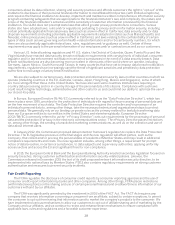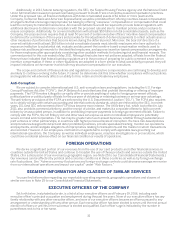American Express 2015 Annual Report Download - page 45
Download and view the complete annual report
Please find page 45 of the 2015 American Express annual report below. You can navigate through the pages in the report by either clicking on the pages listed below, or by using the keyword search tool below to find specific information within the annual report.
programs or merchant acceptance than we have. We may not be able to compete effectively against these threats or
respond or adapt to changes in consumer spending habits as effectively as our competitors.
Spending on our cards could continue to be impacted by increasing consumer usage of debit cards issued on
competitive networks, as well as adoption of payment systems based on ACH or other payment mechanisms. To the
extent alternative payment mechanisms, systems and products continue to successfully expand, our discount
revenues and our ability to access transaction data through our closed-loop network could be negatively impacted. If
we are not able to differentiate ourselves from our competitors, drive value for our customers and/or effectively grow
in areas such as mobile and online payments, fee-based services and emerging technologies, we may not be able to
compete effectively against these threats.
To the extent we expand into new business areas and new geographic regions, we may face competitors with
more experience and more established relationships with relevant customers, regulators and industry participants,
which could adversely affect our ability to compete. We may face additional compliance and regulatory risk to the
extent that we expand into new business areas and we may need to dedicate more expense, time and resources to
comply with regulatory requirements than our competitors, particularly those that are not regulated financial
institutions. In addition, companies that control access to consumer and merchant payment method preferences
through digital wallets, mobile applications or at the point of sale could choose not to accept or could suppress use of
our products or could restrict our access to our customers and transaction data. Such companies could also require
payments from us to participate in such digital wallets and applications, impacting our profitability on transactions.
Laws and business practices that favor local competitors, require card transactions to be routed over domestic
networks or prohibit or limit foreign ownership of certain businesses could slow our growth in international regions.
Further, expanding our service offerings, adding customer acquisition channels and forming new partnerships could
have higher cost structures than our current arrangements, adversely impact our average discount rate or dilute our
brand.
Many of our competitors are subject to different, and in some cases, less stringent, legislative and regulatory
regimes. More restrictive laws and regulations that do not apply to all of our competitors can put us at a competitive
disadvantage, including prohibiting us from engaging in certain transactions, regulating our contract terms and
practices governing merchant card acceptance or adversely affecting our cost structure. See “Ongoing legal
proceedings regarding provisions in our merchant contracts could have a material adverse effect on our business, result
in additional litigation and/or arbitrations, subject us to substantial monetary damages and damage our reputation and
brand” for a discussion of the potential impact on our ability to compete effectively if ongoing legal proceedings limit
our ability to prevent merchants from engaging in various actions to discriminate against our card products.
We face continued intense competitive pressure that may impact the prices we charge merchants that accept
our cards for payment for goods and services.
Unlike our competitors in the payments industry that rely on high revolving credit balances to drive profits, our
business model is focused on Card Member spending. Discount revenue, which represents fees generally charged to
merchants when Card Members use their cards to purchase goods and services on our network, is primarily driven by
billed business volumes and is our largest single revenue source. In recent years, we experienced some reduction in
our global weighted average merchant discount rate and have been under increasing market pressure, including
pressure created by regulatory-mandated reductions to competitors’ pricing, to reduce merchant discount rates and
undertake other repricing initiatives. We also face pressure from competitors that have other sources of income or
lower expense bases that can make their pricing more attractive to key business partners and merchants. Merchants
are also able to negotiate incentives and pricing concessions from us as a condition to accepting our cards. As
merchants consolidate and become even larger, we may have to increase the amount of incentives and/or
concessions we provide to certain merchants, which could materially and adversely affect our results of operations.
Competitive and regulatory pressures on pricing could make it difficult to offset the costs of these incentives.
In addition, differentiated payment models and technologies from non-traditional players in the alternative
payments space and the regulatory and litigation environment could pose challenges to our traditional payment model
and adversely impact our average discount rate. Some merchants also continue to invest in their own payment
solutions, such as proprietary-branded mobile wallets and the CurrentC app on the Merchant Customer Exchange,
using both traditional and new technology platforms. If merchants are able to drive broad consumer adoption and
usage, it could adversely impact our merchant discount rate and billed business volumes.
A continuing priority of ours is to drive greater and differentiated value to our merchants, which, if not successful,
could negatively impact our discount revenue and financial results. If we continue to experience a decline in the
average merchant discount rate, we will need to find ways to offset the financial impact by increasing billed business
volumes, increasing other sources of revenue, such as fee-based revenue or interest income, or both. We may not
succeed in sustaining merchant discount rates or offsetting the impact of declining merchant discount rates,
particularly in the current regulatory environment, which could materially and adversely affect our revenues and
profitability, and therefore our ability to invest in innovation and in value-added services to merchants and Card
Members.
34
























